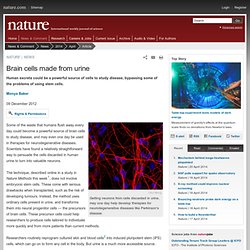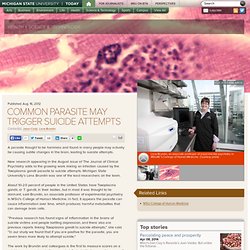

Brain cells made from urine. Lihui Wang Getting neurons from cells discarded in urine, may one day help develop therapies for neurodegenerative diseases like Parkinson's disease.

Some of the waste that humans flush away every day could become a powerful source of brain cells to study disease, and may even one day be used in therapies for neurodegenerative diseases. Scientists have found a relatively straightforward way to persuade the cells discarded in human urine to turn into valuable neurons. The technique, described online in a study in Nature Methods this week1, does not involve embryonic stem cells. These come with serious drawbacks when transplanted, such as the risk of developing tumours. Researchers routinely reprogram cultured skin and blood cells2 into induced pluripotent stem (iPS) cells, which can go on to form any cell in the body. However, in that study the team used retroviruses to insert pluripotency genes into cells — a common technique in cell reprogramming.
Gamers prove equal to surgeons in operating robotic surgery tools. Leo Reynolds A maternal nag familiar to the ears of many young gamers usually follows the lines of "you're wasting your life in front of a console. " Browbeaten controller wielders rejoice—a new study from the University of Texas Medical Branch (UTMB) has proven the superior hand-eye coordination skills honed from hours of joystick-based gaming are the same talents required to master the world's most advanced robotic surgery tools. The study sought to identify the developmental effect video games have on training future surgeons. "A new era has started," explained Sami Kilic, lead author of the study and associate professor and director of minimally invasive gynecology at UTMB. Kilic was inspired to conduct the study after seeing his son easily take control of a robotic surgery simulator at a medical convention. A group of physicians studying at UTMB—a world leader in robotic surgery—was put up against US high school and college students in a series of robotic surgery simulation tests.
Paralysis breakthrough: spinal cord damage repaired. Common parasite may trigger suicide attempts. A parasite thought to be harmless and found in many people may actually be causing subtle changes in the brain, leading to suicide attempts.

New research appearing in the August issue of The Journal of Clinical Psychiatry adds to the growing work linking an infection caused by the Toxoplasma gondii parasite to suicide attempts. Michigan State University’s Lena Brundin was one of the lead researchers on the team. About 10-20 percent of people in the United States have Toxoplasma gondii, or T. gondii, in their bodies, but in most it was thought to lie dormant, said Brundin, an associate professor of experimental psychiatry in MSU’s College of Human Medicine. In fact, it appears the parasite can cause inflammation over time, which produces harmful metabolites that can damage brain cells. The work by Brundin and colleagues is the first to measure scores on a suicide assessment scale from people infected with the parasite, some of whom had attempted suicide. Seeing Inside Tissue.
PASADENA, Calif.

—Imagine if doctors could perform surgery without ever having to cut through your skin. Or if they could diagnose cancer by seeing tumors inside the body with a procedure that is as simple as an ultrasound. Thanks to a technique developed by engineers at the California Institute of Technology (Caltech), all of that may be possible in the not-so-distant future. The new method enables researchers to focus light efficiently inside biological tissue. While the previous limit for how deep light could be focused was only about one millimeter, the Caltech team is now able to reach two and a half millimeters. If you crank up the power of light, you might even be able to do away with a traditional scalpel. Ying Min Wang, a graduate student in electrical engineering, and Benjamin Judkewitz, a postdoctoral scholar, are the lead authors on the paper, which was published in the June 26 issue of the journal Nature Communications.
Written by Marcus Woo.